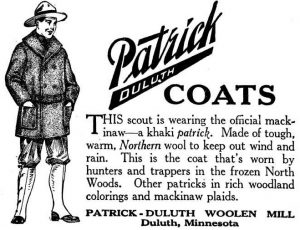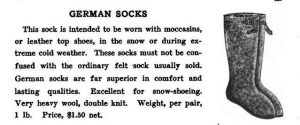Following the description on Kephart’s Autumn Outfit, I will add his recommendations for dressing for cold weather:


Cold Weather Clothing.— The main fault of most cold weather rigs is that, paradoxically, they -re too hot. You go out into '“twenty-some-odd” below zero, all muffled up in thick underwear, overshirt, heavy trousers, and a 32-ounce (to the yard) Mackinaw coat. Very nice, until you get your stride. In half an hour the sweat will be streaming from you enough to turn a mill. By and by you may have to stand still for quite a while. Then the moisture begins to freeze, and a buffalo robe wouldn’t keep you warm. Conditions vary ; but for average winter work put on two suits of medium weight all-wool underwear, instead of one heavy one, moleskin trousers (heavy Mackinaws chafe), wool overshirt, Mackinaw shirt worn with tail outside, so it can easily be removed and worn behind you when not needed, the rubber “overs” and socks mentioned above, a Mackinaw cap with visor and ear flaps, large, old kid gloves, and thick, woolen mittens held by a cord around the neck. In buying Mackinaws get none but the best quality. Cheap Mackinaw is shoddy, or part cotton, and soaks up moisture like a sponge. A good grade sheds rain so long as the nap is not worn off; then it can be waterproofed by the lanolin process. It is noiseless, and stands rough usage. The natural gray color is best, except where the law requires you to wear red for protection against gun-bearing fools. (About this, saith our friend Crossman: “Yes, some fellow might take you for a deer if you wore an inconspicuous color in the woods, but what would you? He’d take you for a zebra if you wore green and yellow, or shoot you for a forest fire it you wore flaming crimson.”)

In the previous section referenced to above Kephart writes:
Rubber Footwear.— I never wear waders for summer trout fishing, but early spring fishing is a different matter. Wading stockings require special hobnailed shoes to go over them. I prefer a pair of light hip boots and separate wading sandals studded with nails. This combination costs less than the other, is more durable, and the boots by themselves are serviceable for general wet weather wear, marsh shooting, and the like. Light rubber boots of first-class quality will last as long as the common heavy ones, and have the advantage that the legs can be turned inside out clear to the ankle for drying. They need not weigh over 3 or 3½ pounds to the pair, and the sandals a pound more — together no more than the high-topped leather boots that I have been objurgating. Have them large enough for both socks and oversocks, then your feet are not likely to get “scalded”. Carry a couple of “eezy-quick” menders, and have a rubber repair kit among your possibles in camp.
For hunting big game In wet snow and slush the best footwear is a pair of rubber shoes with ten-inch leather uppers, weighing a bit over two pounds. They should have heels, if you go into a hilly country, and rough corrugated soles. Dress the feet with soft woolen socks, and over these draw a pair of long, thick “German socks” that strap at the top. The latter are warmer than the loose felt boots worn by lumbermen, lighter, more flexible, fit better, and are easier to dry out. The rubbers should fit properly over the heavy socks, neither too tight nor too loose, but especially not too tight or you risk frostbite! Thus equipped, a still-hunter is “shod with silence.” For cold weather the vital necessity is suppleness of the foot, and here you have it.